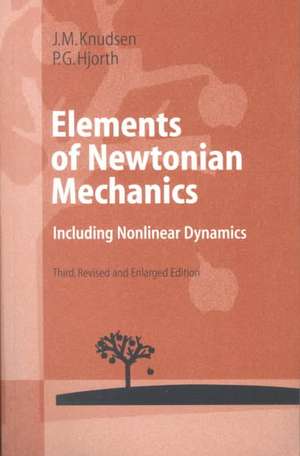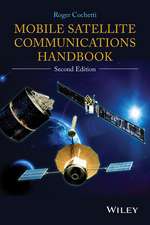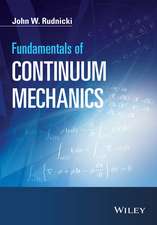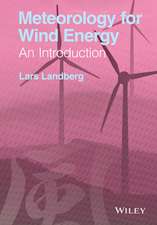Elements of Newtonian Mechanics: Including Nonlinear Dynamics: Advanced Texts in Physics
Autor Jens M. Knudsen, Poul G. Hjorthen Limba Engleză Paperback – 21 iun 2000
Din seria Advanced Texts in Physics
- 18%
 Preț: 792.96 lei
Preț: 792.96 lei - 15%
 Preț: 590.30 lei
Preț: 590.30 lei -
 Preț: 202.50 lei
Preț: 202.50 lei - 15%
 Preț: 468.57 lei
Preț: 468.57 lei - 15%
 Preț: 710.75 lei
Preț: 710.75 lei - 15%
 Preț: 475.62 lei
Preț: 475.62 lei - 15%
 Preț: 571.96 lei
Preț: 571.96 lei -
 Preț: 393.35 lei
Preț: 393.35 lei -
 Preț: 395.47 lei
Preț: 395.47 lei -
 Preț: 403.75 lei
Preț: 403.75 lei -
 Preț: 413.15 lei
Preț: 413.15 lei - 15%
 Preț: 658.70 lei
Preț: 658.70 lei - 18%
 Preț: 778.74 lei
Preț: 778.74 lei - 18%
 Preț: 720.53 lei
Preț: 720.53 lei - 18%
 Preț: 975.10 lei
Preț: 975.10 lei -
 Preț: 412.78 lei
Preț: 412.78 lei - 15%
 Preț: 713.69 lei
Preț: 713.69 lei -
 Preț: 402.76 lei
Preț: 402.76 lei - 15%
 Preț: 588.50 lei
Preț: 588.50 lei - 15%
 Preț: 542.04 lei
Preț: 542.04 lei - 15%
 Preț: 651.84 lei
Preț: 651.84 lei - 18%
 Preț: 739.81 lei
Preț: 739.81 lei - 15%
 Preț: 646.11 lei
Preț: 646.11 lei - 15%
 Preț: 653.14 lei
Preț: 653.14 lei - 23%
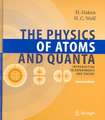 Preț: 676.67 lei
Preț: 676.67 lei - 18%
 Preț: 730.79 lei
Preț: 730.79 lei - 15%
 Preț: 644.30 lei
Preț: 644.30 lei - 15%
 Preț: 543.34 lei
Preț: 543.34 lei - 15%
 Preț: 652.17 lei
Preț: 652.17 lei -
 Preț: 388.52 lei
Preț: 388.52 lei - 15%
 Preț: 605.20 lei
Preț: 605.20 lei - 18%
 Preț: 798.50 lei
Preț: 798.50 lei - 18%
 Preț: 1852.57 lei
Preț: 1852.57 lei - 18%
 Preț: 947.85 lei
Preț: 947.85 lei - 18%
 Preț: 969.44 lei
Preț: 969.44 lei
Preț: 480.02 lei
Nou
Puncte Express: 720
Preț estimativ în valută:
91.86€ • 99.75$ • 77.16£
91.86€ • 99.75$ • 77.16£
Carte disponibilă
Livrare economică 28 martie-03 aprilie
Livrare express 18-22 martie pentru 53.81 lei
Preluare comenzi: 021 569.72.76
Specificații
ISBN-13: 9783540676522
ISBN-10: 354067652X
Pagini: 472
Ilustrații: XX, 452 p. 1 illus.
Dimensiuni: 155 x 235 x 25 mm
Greutate: 0.71 kg
Ediția:3rd rev. and enlarged ed. 2000
Editura: Springer Berlin, Heidelberg
Colecția Springer
Seria Advanced Texts in Physics
Locul publicării:Berlin, Heidelberg, Germany
ISBN-10: 354067652X
Pagini: 472
Ilustrații: XX, 452 p. 1 illus.
Dimensiuni: 155 x 235 x 25 mm
Greutate: 0.71 kg
Ediția:3rd rev. and enlarged ed. 2000
Editura: Springer Berlin, Heidelberg
Colecția Springer
Seria Advanced Texts in Physics
Locul publicării:Berlin, Heidelberg, Germany
Public țintă
Lower undergraduateCuprins
1. The Foundation of Classical Mechanics.- 1.1 Principia.- 1.2 Prerequisites for Newton.- 1.3 The Masterpiece.- 1.4 Concluding Remarks.- 1.5 Problems.- 2. Newton’s Five Laws.- 2.1 Newton’s Laws of Motion.- 2.2 Integration of the Equation of Motion.- 2.3 Problems.- 3. Gravitational and Inertial Mass.- 3.1 Gravitational Mass.- 3.2 Inertial Mass.- 3.3 Proportionality Between Inertial and Gravitational Mass.- 3.4 Newtonl’s Experiment.- 3.5 Problem.- 4. The Galilei Transformation.- 4.1 The Galilei Transformation.- 4.2 Galileo Speaks.- 4.3 Problems.- 5. The Motion of the Earth.- 5.1 Examples.- 5.2 Problems.- 6. Motion in Accelerated Reference Frames.- 6.1 Newton’s 2nd Law Within Accelerated Reference Frames.- 6.2 The Equivalence Principle of Mechanics.- 6.3 The Einstein Box.- 6.4 The Centrifugal Force.- 6.5 Tidal Fields.- 6.6 The Coriolis Force.- 6.7 Tidal Forces and Local Inertial Frames.- 6.8 The Foucault Pendulum.- 6.9 Newton’s Bucket.- 6.10 Review: Fictitious Forces.- 6.11 Problems.- 7. The Problem of Motion.- 7.1 Kinematic and Dynamic Views of the Problem of Motion.- 7.2 Einstein Speaks.- 7.3 Symmetry.- 7.4 The Symmetry (Invariance) of Newton’s 2nd Law.- 7.5 Limited Absolute Space.- 7.6 The Asymmetry (Variance) of Newton’s 2nd Law.- 7.7 Critique of the Newtonian View.- 7.8 Concluding Remarks.- 8. Energy.- 8.1 Work and Kinetic Energy.- 8.2 Conservative Force Fields.- 8.3 Central Force Fields.- 8.4 Potential Energy and Conservation of Energy.- 8.5 Calculation of Potential Energy.- 8.6 The Gravitational Field Around a Homogeneous Sphere.- 8.7 Examples.- 8.8 Review: Conservative Forces and Potential Energy.- 8.9 Problems.- 9. The Center-of-Mass Theorem.- 9.1 The Center of Mass.- 9.2 The Center-of-Mass Frame.- 9.3 Examples.- 9.4 Review: Center of Mass andCenter-of-Mass Theorems.- 9.5 Comments on the Conservation Theorems.- 9.6 Problems.- 10. The Angular Momentum Theorem.- 10.1 The Angular Momentum Theorem for a Particle.- 10.2 Conservation of Angular Momentum.- 10.3 Torque and Angular Momentum Around an Axis.- 10.4 The Angular Momentum Theorem for a System of Particles.- 10.5 Center of Gravity.- 10.6 Angular Momentum Around the Center of Mass.- 10.7 Review: Equations of Motion for a System of Particles.- 10.8 Examples of Conservation of Angular Momentum.- 11. Rotation of a Rigid Body.- 11.1 Equations of Motion.- 11.2 The Rotation Vector.- 11.3 Kinetic Energy of a Rotating Disk.- 11.4 Angular Momentum of an Arbitrary Rigid Body in Rotation Around a Fixed Axis.- 11.5 Calculation of the Moment of Inertia for Simple Bodies.- 11.6 Equation of Motion for a Rigid Body Rotating Around a Fixed Axis.- 11.7 Work and Power in the Rotation of a Rigid Body Around a Fixed Axis.- 11.8 The Angular Momentum Theorem Referred to Various Points.- 11.9 Examples.- 11.10 Review: Linear Motion and Rotation About a Fixed Axis. 266 11.11 Problems.- 12. The Laws of Motion.- 12.1 Review: Classical Mechanics.- 12.2 Remarks on the Three Conservation Theorems.- 12.3 Examples.- 12.4 Problems.- 13. The General Motion of a Rigid Body.- 13.1 Inertia in Rotational Motion.- 13.2 The Inertia Tensor.- 13.3 Euler’s Equations.- 13.4 Kinetic Energy.- 13.5 Determination of the Principal Coordinate System.- 13.6 Problems.- 14. The Motion of the Planets.- 14.1 Tycho Brahe.- 14.2 Kepler and the Orbit of Mars.- 14.3 Conic Sections.- 14.4 Newton’s Law of Gravity Derived from Kepler’s Laws.- 14.5 The Kepler Problem.- 14.6 The Effective Potential.- 14.7 The Two-Body Problem.- 14.8 Double Stars: The Motion of the Heliocentric Reference Frame.- 14.9 Review: KeplerMotion.- 14.10 Examples.- 14.11 Problems.- 15. Harmonic Oscillators.- 15.1 Small Oscillations.- 15.2 Energy in Harmonic Oscillators.- 15.3 Free Damped Oscillations.- 15.4 Energy in Free, Weakly Damped Oscillations.- 15.5 Forced Oscillations.- 15.6 The Forced Damped Harmonic Oscillator.- 15.7 Frequency Characteristics.- 15.8 Power Absorption.- 15.9 The Q-Value of a Weakly Damped Harmonic Oscillator.- 15.10 The Lorentz Curve.- 15.11 Complex Numbers.- 15.12 Problems.- 16. Remarks on Nonlinearity and Chaos.- 16.1 Determinism vs Predictability.- 16.2 Linear and Nonliner Differential Equations.- 16.3 Phase Space.- 16.4 A Forced, Damped Nonlinear Oscillator.- 16.5 Liapunov Exponents.- 16.6 Chaos in the Solar System.- 16.7 Problems.- Appendix. Vectors and Vector Calculus.- Selected References.- Answers to Problems.
Recenzii
This book provides an excellent introduction to Newtonian mechanics at an undergraduate level, it is used at University of Copenhague. All the classical topics are presented in a very clear way an discussed with many physicaI examples. The book is divided in 16 chapters and contains more than 100 problerns, of various difficulties, with solutions. It's pedagogical conception is absolutely remarkable, all concepts are carefully introduced and physically discussed with mamy details. Foundation of classical mechanics is first introduced and commented on many problems like acceleration of gravity, circular motion or conmunication satellite. Next chapter is devoted to Newton's laws of motion, more than 30 pages of the book contains examples, on direct applications of these law, from: various fields of physics. Gravitational and inertial mass are discussed in the next chapter and is followed by the concept of Galilei transformation. The next three chapters examine the problem of motion respectively of the Earth, in accelerated reference frames and at the kinematic and dynamic point of view. Energy, Center-of Mass and angular momentum theorem are analysed with some details in chapters 8-10. The problem of rigid body including the motion of the planets and the Kepler Iaws are presented and discussed with great attention. The book ends with the important problem of harmonic oscillators and some remarks on non-linear dynamics. In conclusion I warmly recommend this book to everyone interesting in Newtonian mechanics.
S. Metens. Physicalia, 2001/XXXVII/4
"The book presents an excellant description of basic principles of classical mechanics....This book can be useful not only to students, but also to specialists who teach the powerful methods of Newtonian mechanics and the imaginary Newton's world governed by laws of classical mechanics."-Zentralblatt MATH
S. Metens. Physicalia, 2001/XXXVII/4
"The book presents an excellant description of basic principles of classical mechanics....This book can be useful not only to students, but also to specialists who teach the powerful methods of Newtonian mechanics and the imaginary Newton's world governed by laws of classical mechanics."-Zentralblatt MATH
Textul de pe ultima copertă
This textbook provides a thorough introduction to Newtonian Mechanics and is intended for university students in physics, astronomy and engineering. It is based on a course for which Dr. Knudsen earned an award for the best teaching at the University of Copenhagen, Denmark. More than 100 problems with solutions and 89 worked examples help the student to grasp the essential aspects of the subject, and to develop proficiency in using the powerful methods of Newtonian mechanics. Moreover, the fundamental problem of motion and the concept of inertial frames is faced from the very beginning, and runs through the entire development of classical mechanics. This new and fresh approach is presented in its third edition, which has been revised and enlarged.
Caracteristici
Best-selling approach to Newtonian Mechanics New section about Spin-Orbit locking Problems with solutions Includes supplementary material: sn.pub/extras
